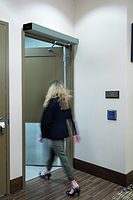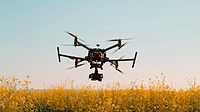Physical security’s role in building the “new normal”

As the country continues to work on the process of reopening its businesses, schools, stores and public places, the vision for a “new normal” has begun to emerge. Today’s world looks drastically different than it did just six months ago, and we all need to be prepared to adapt to new systems and processes for the long term. This severe level of disruption has put new demands on physical security teams and stimulated new innovations. How do you track facility and crowd capacities? How do you enforce mask mandates and effectively do temperature testing? Are rapid tests on a regular basis realistic and accurate? What changes in facility layouts are needed in order to meet social distancing best practices? How do you keep a facility clean 24/7? Physical security, public safety and health tech and policies have never been more tied together.
As the term “new normal” implies, these physical security and health needs are now the long-term reality facing the country. For essential workplaces, as companies bring workers back into buildings, schools, stores or essentially anywhere – everyone needs to be thinking about the long-term changes required to keep employees and the public safe. For just about every industry looking to boost their physical security standards, it’s going to start with the types of technology and processes that they decide to deploy and are required to implement. In this new normal, security professionals now have both a physical security and health monitoring responsibility.
Technology is the most critical public safety tool, along with participatory compliance
Only with the widespread adoption of new technologies and systems, such as smart video, IoT devices, more automation, mobile solutions, biometrics and real-time/rapid health testing and more - will the country see long-term public safety success. With this fast-moving dynamic, not every new technology is ready for the challenges presented by a pandemic, and for many organizations it’s now about balancing effectiveness with timeliness, and diligence without panic. And not to be overlooked, training and compliance for people following new rules is essential to avoid the weakest link syndrome.
Facial recognition technology, while controversial for some use cases and related to personal privacy, has proven useful when managed responsibly. Technology can be useful for managing access control in big office buildings or workplaces with large physical footprints like warehouses or industrial sites, as well as in public facility threat vectors like airports and stadiums. Facial recognition can also help employees gain access to specific areas that are usually protected through keypads or key cards, that would now be considered unhygienic.
Facial recognition was hotly debated even before the pandemic, and now many of those technologies are being put to the test. There are a number of studies being performed to not only determine the accuracy of such technology, but the accuracy of that technology with the added complication of a person wearing a mask. And, the Security Industry Association has been producing comprehensive analysis of the topic. It’s an important example of physical security technology that has been working its way into more mainstream adoption that is likely to skyrocket in the near future, while needing responsible regulation and oversight.
Smart video surveillance, imaging and analytics use cases are surging across multiple verticals in which the combination physical security, health best practices and monitoring, and customer intelligence and experience all have value. This also is extending to desired new urban planning outcomes like traffic management and parking control, and more outdoor restaurants, bars and entertainment venues as cities start to reimagine goals for the post-pandemic mode and get serious about sustainability, as well as to better prevent and respond to crime, theft and violence.
The security industry’s obligation in creating a safer future
Public health is now a physical security concern and regardless of an organization’s size, budget or personal stance on the pandemic, it’s an obligation for the industry to ensure the “new normal” is a safe one. This applies to both private organization security teams, law enforcement and first responders’ communities.
Stores, schools and businesses must spend time, even with their limited budgets, learning how to best justify the cost of physical security technology and how they can leverage what already exists to “pandemic-proof” for the future. Even if an organization doesn’t have a dedicated in-house security team or expert, organizations need to ensure employees should feel empowered and educated on current protocols in place and the training or knowledge necessary to see it into action.
Ensuring public safety requires the entire industry to work together like never before. As new technologies are rolled out, we’ll start to see long-term innovations the pandemic has stimulated, from how shoppers line up in stores to bringing back spectator sports in a safe way. Moving forward, it’s everyone’s responsibility to start building positive case studies for the future now, to prepare for the next challenge that will emerge and for long-term success and well-being.
Looking for a reprint of this article?
From high-res PDFs to custom plaques, order your copy today!






